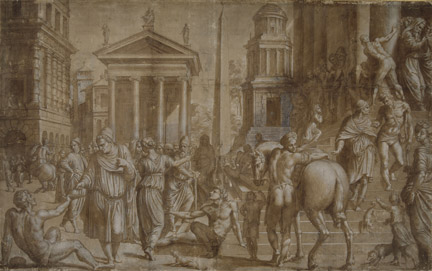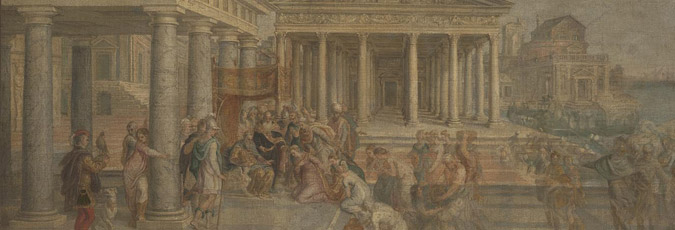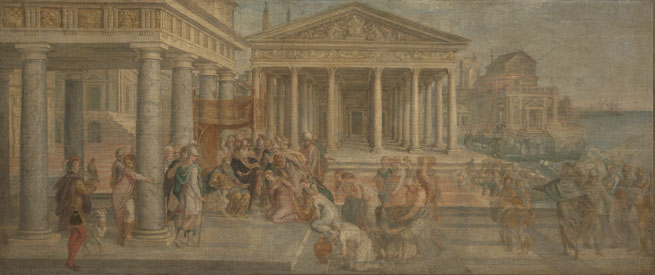Lambert Sustris (about 1515/20–about 1570)
'The Queen of Sheba before King Solomon', about 1540–55
Oil on canvas, 80 x 187.3cm
NG3107
Architecture is the main protagonist in this painting and the figures are planned to fit into a dominant setting. This effect is heightened by the condition of the canvas, in which the thinly painted, worn and partly translucent figures seem to be merging with their environment. It is evident that the architecture was painted before the figures. Nicholas Penny notes the presence of red chalk and perhaps ruled or incised lines in the architecture of the main buildings.1
The composition is structured around two great buildings set at right angles to each other, creating a piazza space between them. This is quite different from two other works showing arrivals at a temple: Titian’s ‘Presentation of the Virgin’ painted for Santa Maria della Carità (still in situ, in the Accademia, Venice), where the stairs dominate and only the door to the temple is visible; and Marcantonio’s print of the same subject, in which the temple is behind the figure group and not integral to it. Sustris creates a massive open loggia close to the picture plane on the left, his figures interacting with the grey marble columns, mounting or kneeling on the steps, and occupying the space within and in front of the loggia. This foreground loggia, atrium or portico is designed not only as a shelter for Solomon and his court, but also to be an impressive, welcoming structure that functions as a beacon-like destination for Sheba’s retinue as it approaches from the harbour.
This building is too close to allow more than a glimpse of its attic storey, so it is impossible to tell whether it is the projecting portico of a temple or an 'all'antica' version of a ceremonial civic loggia, like the Loggia dei Lanzi in Florence2 or the Loggetta below the Campanile in Venice. Its architectural presence depends not only on the grey marble columns, Doric entablature (with triglyphs, metopes and guttae), and grey-and-white marble podium, but also on the deep spaciousness and shade created under its roof.
Solomon's Temple
The other great building, in the centre of the picture and facing the viewer, is unquestionably a temple, and almost certainly represents Solomon’s Temple. Its Corinthian splendour is expressed through its six-columned façade, its portico as deep as it is wide, its frieze sculpted with swags, imperial eagles, lions and masks, and its pediment with a fictive relief of subjects kneeling before an enthroned ruler or figure of justice, which is surely another image of Solomon. It is grander than the model that inspired it – the Pantheon in Rome – which has eight more narrowly spaced columns along its façade but is only four columns deep.3 Thus Sustris exploits the power of perspectival depth, turning what is often a shallow façade feature – the portico – into a deep, mysterious, column-filled space.4 This is Palladian architecture on a grand scale: scenographic, well proportioned, strong and magnificent.
The island church or temple standing sentinel in the harbour resembles San Giorgio Maggiore in Venice, its relationship to the Molo (waterfront) with gondolas drawn up, leading directly into a paved piazza, its space defined by the adjacent façades of splendid civic buildings, derives from Venice and its Piazzetta.5 It is therefore linked to other works depicting the Queen of Sheba and King Solomon in Venice, such as the long painting attributed to Antonio Palma in the sacristy of the Frari in Venice (1550s),6 and Tintoretto's version of the subject now in the Accademia. Perhaps the closest in terms of architectural composition is Tintoretto’s cassone painting in the Kunsthistorisches Museum in Vienna (‘The Queen of Sheba before Solomon’, 1543). Here too we look directly across a piazza at a deep loggia with columns, while Solomon and Sheba meet in another portico at right angles to the viewer.
Solomonic architecture
The meeting of Solomon and Sheba had been a popular subject for the painters of cassoni and spalliere in the 15th century.7 Those artists pioneered the use of elaborate temples – what we might refer to as Solomonic architecture – in which the justice, wisdom and regal power of Solomon are expounded architecturally, combined with Sheba’s journey by sea.8 Sustris carries this architectural emphasis further, endowing each building with a different architectural character: the Corinthian temple; the Doric loggia; and behind, a building with pilasters framing tabernacle doors standing on a projecting basement with stairs and rustic doorways that seems to have been inspired by Giulio Romano and Serlio.9 These bold architectural types appear in a similar configuration in Peruzzi’s ‘Presentation of the Virgin in the Temple’ in Santa Maria della Pace in Rome (about 1517–26), the modello for which is shown here (fig. 1).

Here, the portico of one temple is seen side on and cut off by the frame (foreground right), another temple is set back but displayed frontally, and a third building has a rusticated ‘basamento’ and deep doorways.10 The way in which Sustris’s figures inhabit and use the temple and the piazza may also be indebted to Peruzzi, although Sustris makes his figures smaller in relation to the architecture and his buildings therefore appear more convincingly majestic. Rather than creating isolated set pieces, by using the buildings to create a welcoming urban space and by fully integrating the narrative of Sheba’s voyage by sea into the design of a waterfront piazza, Sustris manages to create a unified urban vision.
Boucher in London 1975, cat. no. 86, p. 56; Penny and Spring 1996, pp. 47–8; Penny 2008, pp. 126–31.
This material was published in April 2014 to coincide with the National Gallery exhibition 'Building the Picture: Architecture in Italian Renaissance Painting'.
To cite this essay we suggest using
Amanda Lillie, ‘Lambert Sustris, The Queen of Sheba before King Solomon’ published online 2014, in 'Building the Picture: Architecture in Italian Renaissance Painting', The National Gallery, London, http://www.nationalgallery.org.uk/research/research-resources/exhibition-catalogues/building-the-picture/place-making/sustris-sheba-before-solomon


